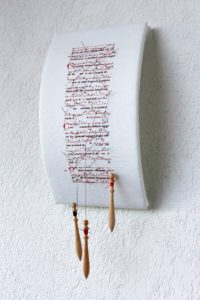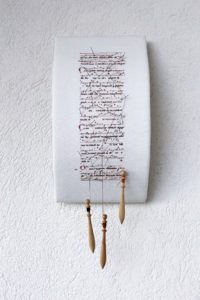 Partitura n.1 (Score Nr. 1)
Partitura n.1 (Score Nr. 1)
Donatella Lombardo
2016
Digital print on linen, needles, coloured thread, bobbins, plexiglass, adhesive paper, polyurethane padding, threaded screws
48 cm x 20 cm x 13 cm incl. 3 bobbins
The base of “Partitura n.1” by Donatella Lombardo is an upholstered segmental arch, with a white linen surface. Printed on it are neumes (medieval musical notations) and Latin song lyrics. There are several needles placed in the printed zone, which are connected by red and black threads. At the bottom, these threads are ending in three free suspended wooden bobbins.
“Partitura n.1” shows an extract of compositions by the German Benedictine abbes Hildegard von Bingen (1098-1179). It is a copy taken from the collection “Symphonia armonie celestium revelationum” (Symphony of the Harmony of Heavenly Revelations) which contains 73 liturgical songs, four of it without musical notations. The original is part of the Riesenkodex (giant codex), of the Hessische Landesbibliothek (Hessian State library), Wiesbaden, Germany. We see the right column of folio 467 with four psalm antiphons. Completely visible are “Cum processit factura” (Although the craft came forth) and “Cum erubuerint” (While downcast parents blushed).
 Besides the reproduction of the psalm antipodes and with that a re-materialisation of the music, the support has an important role. The upholstered, linen covered segmental arch recalls a traditional lace pillow. In addition, the needles connected by threads encourage this impression as well as the suspended bobbins. Donatella has chosen this form of presentation, to remind that textile handicrafts were a main activity of woman from the upper class for centuries, even though it was not an always beloved occupation.
Besides the reproduction of the psalm antipodes and with that a re-materialisation of the music, the support has an important role. The upholstered, linen covered segmental arch recalls a traditional lace pillow. In addition, the needles connected by threads encourage this impression as well as the suspended bobbins. Donatella has chosen this form of presentation, to remind that textile handicrafts were a main activity of woman from the upper class for centuries, even though it was not an always beloved occupation.
It is to remark, that manufacturing of bobbin lace should be seen as well as placeholder for other textile handicrafts, since the bobbin lace was only documented at the end of the 15th century in Milan. Therefore, it presumably was invented in Italy. In addition, it is traditional handicraft in Sicily, Donatella’s home region.
Before and besides production of bobbin laces, women were occupied with spinning and stitching. For female members of the upper classes, for a long time the only getaway from doing handicrafts and bearing children was to enter into a monastery. Gifted women, like Hildegard von Bingen, could even achieve an impressive career. Other female composers, especially in modern times, could pursue more or less directly their musical destination. Nevertheless, nowadays they are often forgotten and even contemporary female musicians are underrepresented and less paid.
This led the artist to dedicate a whole series to female composers: the “Partiture mute” (mute scores). “Partitura n.1” is part of it. For “Partiture mute” she reproduced 20 compositions of female composers on a base like our artwork of the month. The chosen creators lived in the Middle Ages, Renaissance, Baroque or in the 19th and early 20th century. Donatella found the documents in digital copy and/or as original in the library of the Conservatorio Statale di Musica Vincenzo Bellini in Palermo, the Conservatorio Musicale Giovan Battista Martini in Bologna or the free online International Music Score Library Project, also known as the Petrucci Music Library.
The series and especially the presented artwork “Partitura n.1” is more than a reproduction of musical notations, even though the image itself is by its medieval design a nice appearance. Moreover, the choice of the supplement materials refers to further information: the bobbin lace arrangement leads to female handicraft; the net of threats might hint to a deprivation of liberty and the needles could represent the injuries that women have to face often. At the same time, female handicraft represents creative work of women. Like composition, it was an outlet for their imagination, even though it was done under difficulties. Donatella introduced the coloured threads and pins as personnel interpretation of the inventive spirit of these women. She wants to underline the importance of female labour for the society in the past and plans to continue this project in the future.
Donatella Lombardo
Born 1980 in Erice, Italy, Donatella studied at the Accademia di Belle Arti (Academy of Fine Arts) in Bologna, Italy and continued her post-graduate studies at the Facoltà di Lettere e Beni Culturali di Bologna (Faculty of Cultural Heritage of the University of Bologna) . Since her first degree in Fine Arts in 2006, she participated in many group exhibitions and had as well personal shows all over Italy. After her Master’s Degree in Preservation and Restoration of Cultural Heritage in 2011, she cooperated for several exhibitions as curator.
For the context of our artwork of the month February 2017 her co-curatorship in two exhibitions with the MAMbo (Museum of Modern Art of Bologna) should be remarked: “Autoritratti I. Nuove Gen(d)erazioni” (Self-portraits I. Gen(d)erations) and “Autoritratti. Iscrizioni del femminile nell’arte italiana Contemporanea” (Self-portraits. Inscriptions of the feminine in Italian contemporary art) in 2013. The coordinator of these projects was Uliana Zanetti.
Nevertheless, Donatella’s work is not only focussed on female issues. Her recent solo exhibition at the Galleria Spazio Testoni in Bologna thematised the digital Medias: “Remediation. Digital memory under deconstruction”. In the presented artworks, she revealed the html-code behind the texts which we read daily on the internet. The creations are an encounter between “technology” and “craftsmanship”, since they mostly show the digital language on natural materials like linen framed by wood. Often the texts are embroidered with red threads.
This is not the only similarity to the series “Partiture mute” (mute scores), which our artwork of the month “Partitura n.1” is part of. The musical notations are, like the html-code, only a special language to tell the musician how to translate it into music.
Donatella lives and works in Castellammare del Golfo.
